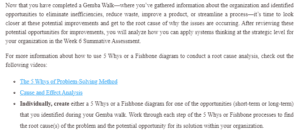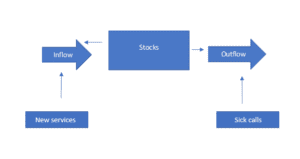Gemba Walk
During the Gemba Walk of our laboratory department, I found three short-term opportunities to improve The short-term opportunities I found on my Gemba Walk for our department are to reduce patient wait times, reduce laboratory test turnaround times, and strengthen staff communication relationships. By addressing these short-term opportunities, we would ensure better patient care outcomes. By improving the staffing communication relationships, the staff will be able to work more efficiently, and in return, patient wait times and turnaround times will be reduced.
One long-term opportunity I could identify is for our department to acquire newer equipment. This would speed up processes and ensure our equipment is not constantly breaking down and causing delays. Over the last couple of months, one of our chemistry analyzers (we have two) has been down (either entirely or partially) for a total of 10 days (not consecutive). This has caused significant headaches for the physicians, nurses, and our staff, who constantly troubleshoot. Thankfully we have a backup analyzer that we are using to continue to put out results, but there is a delay.
The following are 5 Why utilized to help the root cause analysis: Problem: Patient test turnaround time.
Why 1: Physicians are not satisfied because their patient’s test is not being resulted promptly.
Why 2: Their wait time is extended because we do not have enough staff to process the samples, and our analyzers are constantly out of service.
Why 3: The analyzers are older and need to be replaced.
Why 4: The analyzers are not being replaced because we lack the funds allocated to equipment. Instead, they extend the service contract so that when they break down, a technician comes to repair them.
Why 5: the staff does not always report issues with the analyzers; therefore, management can not possibly know the extent of the troubleshooting.
Solution: Spend funds on new analyzers that are more up-to-date and do not require much specimen processing. This way, we don’t have to hire many new staff for the processing department, and the physicians will be satisfied that their patient tests result promptly.
Problem: Patients are unsatisfied with how long it takes our laboratory to see them.
Why 1: Patients are not satisfied because their wait time is extended. Why 2: Their wait time is extended because we do not have enough staff. Why 3: We do not have enough staff because they leave Alvarado. Why 4: They go to Alvarado because they are unhappy at work
Why 5: They are unhappy at work due to unfair compensation, overworked, communication, and management.
Solution: Hire more staff, and speak to the current team to better understand the concerns they are voicing. Hopefully, better communication will improve better employee satisfaction.
Problem: Poor staff communication relationships
Why 1: Staff does not communicate with one another.
Why 2: They do not communicate with one another because they are on different
Shifts. Laboratory leads failed to set the tone for the expectation. Although we like to promote from within because such promotion “also give corporations a well-rounded workforce and one that has performed many jobs-a win-win situation all around.” Silverstein, K. (1999). These leads did not have the skills needed to perform such duties.
Why 3: Leads and prior management failed to set the tone for expectations because they lacked the necessary leadership skills, and now, the staff feels they do not have to do it.
Why 4: They lack these skills because they were never adequately trained.
Why 5: laboratory leads were never adequately trained to be leaders because they were placed in a position they did not necessarily qualify for, and it needed to be filled.
Solution: Hire laboratory leads with the necessary skills. If the laboratory leads hired will remain in the role, they need to be trained accordingly. Regarding the staff, we also took this time to connect with employees and ask for their advice to improve our process. After all, they are the front-line workers. According to Lafarga-Previdi et al. (2021), They often bring new ideas to improve the process. They suggested we schedule daily huddles where communication must be documented from one shift to the next. We will schedule staff meetings and activities so that the staff get to know one another.
Strategy proposal
The greatest strength and opportunity that Alvarado Hospital has is the opening of the Geriatric Behavior Health Program. This health program provides emotional and behavioral care 24 hours daily in an inpatient setting. Patients 55 years and older with behavioral health issues such as anxiety, Dementia, Schizophrenia, and Depression can receive comprehensive treatment from a team of physicians, psychiatrists, nurses, and therapists.
The most significant opportunity this facility has is working with the skilled nursing facilities in the area and the need to support the aging population. Alvarado can partner with these facilities to generate more of an outpatient system. I think taking care of the employees who care for the patients is also essential. Therefore, I believe Alvarado Hospital must create a childcare facility for employees. As mentioned above, in the second problem, there is a staffing issue. I highly believe that having a childcare facility on site for healthcare workers would eliminate many cases.
Chaos theory
The chaos theory applies to this organization’s strategic opportunities. It is understood that change is inevitable and hard to control. Many activities within an organization can be managed while others cannot. As a company grows and the areas of service increase, the possibility of chaos and events also increases. As leaders, we should appropriately staff for the rise in patient numbers.
Systems Thinking Diagram
The diagram above shows our organization’s stock, inflows, outflows, and feedback loops.
The “stock” is the foundation of the department. The “flows” would be the employees and the specimens in and out of our lab and supply inventory. The “new services” represent how much work we have at any given time and how many patients we see daily. This would impact our stock because we would need to hire more staff to keep up with the demand of the new patients. The “sick calls” would affect the outflows because we wouldn’t have enough staff to keep up with the market, hence wait times are longer, and results are delayed. Feedback loops would work to ensure stock is maintained correctly.
References
Lafarga-Previdi, I., Velez-Vega, C.M., & Santiago-Rodriguez, E.I. (2021, December).
Assessment of academic-community partnerships in translational research. Puerto Rico Health Sciences Journal, 40(4), 157+. https://link.gale.com/apps/doc/A684372836/AONE?u=uphoenix&sid=ebsco&xid=a4173d9e
Silverstein, K. (1999). Growing from within. Utility Business, 2(8), 59-60. https://www.proquest.com/trade-journals/growing-within/docview/195755201/se-2? accountid=35812
ORDER A PLAGIARISM-FREE PAPER HERE
We’ll write everything from scratch
Question
Assignment Content
Now that you have completed a Gemba Walk—where you’ve gathered information about the organization and identified opportunities to eliminate inefficiencies, reduce waste, improve a product, or streamline a process—it’s time to look closer at these potential improvements and get to the root cause of why the issues are occurring. After reviewing these potential improvement opportunities, you will analyze how you can apply systems thinking strategically for your organization in the Week 6 Summative Assessment.

Gemba Walk
For more information about how to use 5 Whys or a Fishbone diagram to conduct a root cause analysis, check out the following videos:
-
- The 5 Whys of Problem-Solving Method
- Cause and Effect Analysis
- Individually, create either a 5 Whys or a Fishbone diagram for one of the opportunities (short-term or long-term) that you identified during your Gemba walk. Work through each step of the 5 Whys or Fishbone processes to find the root cause(s) of the problem and the potential opportunity for its solution within your organization.


